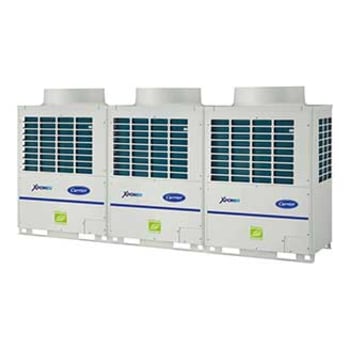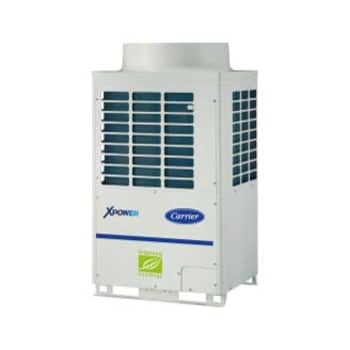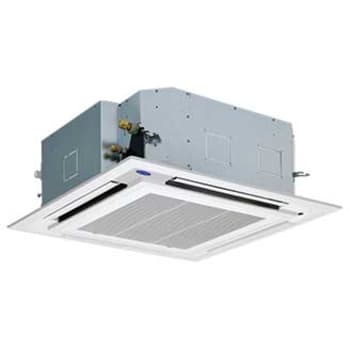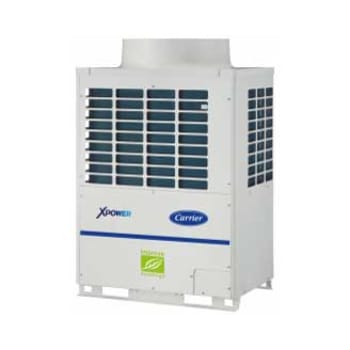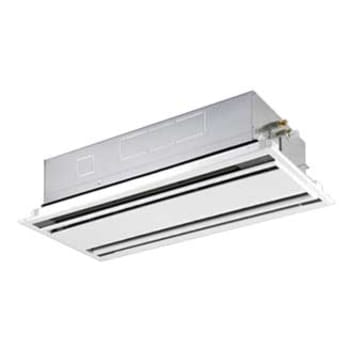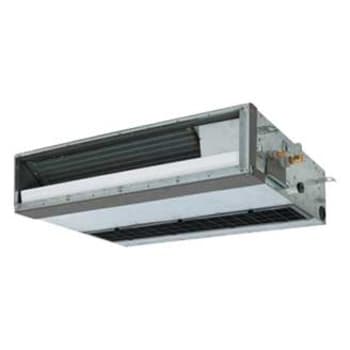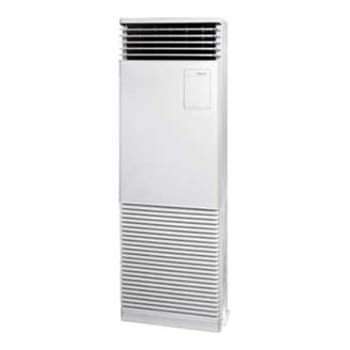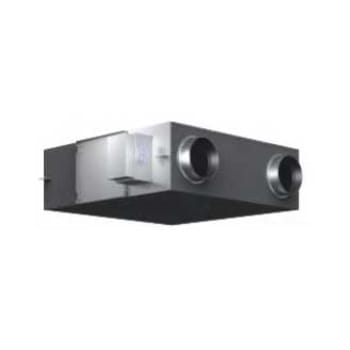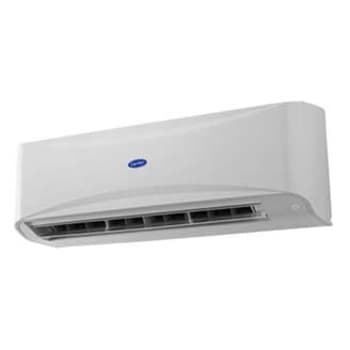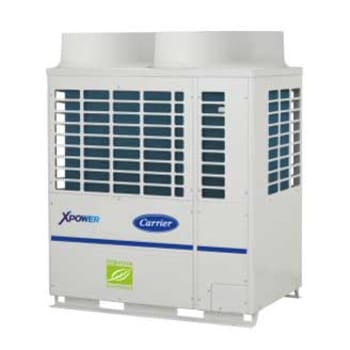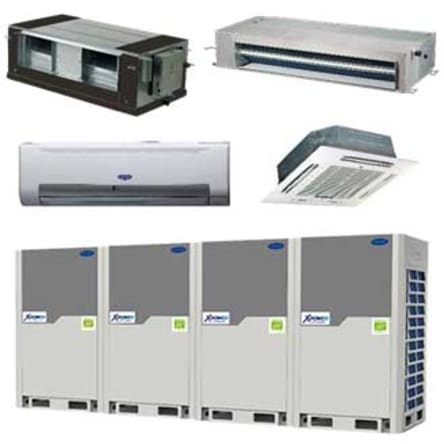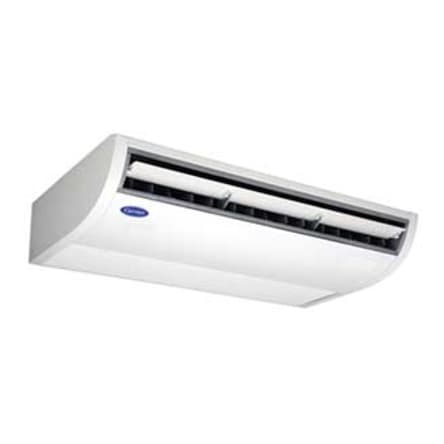XPower
Variable Refrigerant Flow System
Wide capacity range: 4HP to 56HP
Extreme ambient operation: -20°C to 52°C
Puron® (R-410A) Refrigerant
Single unit capacity: 4HP, 5HP, 6HP, 8HP, 10HP, 12HP, 14HP, 16HP, 18HP & 20HP
Combination ratio: 50% - 135%
Suitable to precisely match the building’s cooling and heating demands, Carrier® VRF systems utilize a 2-pipe system for heat pump high ambient models. A single outdoor VRF condenser can power up to 64 independent indoor units, depending on the system. This provides superior zoning because the refrigerant flow can vary from location to location, delivering only the necessary capacity to each zone. The system adjusts the flow of refrigerant to each indoor unit based on its operating conditions. It computes the amount of refrigerant required by each indoor unit and controls the refrigerant flow to ensure desired comfort level for each and every room.

With VRF technology, heating and cooling only the spaces that need it is simple. These systems circulate the minimum amount of refrigerant needed for each individual zone to satisfy the building load. Since there are no ducts, this eliminates the energy waste associated with the duct loss.
Simultaneous Heating & Cooling :
Heat recovery and flexible refrigerant flow make it possible to heat and cool different zones on a single refrigerant piping system at any given time. This also helps increase efficiency by capturing what would have been wasted energy from one space and returning it to the other space as useful energy.
Inverter-Driven Compressors
Every outdoor unit is equipped with multiple inverter-driven compressors that provide efficiency and comfort.
Reliability:
The operating sequence of the individual compressors is rotated, balancing their operating hours and distributing load evenly. Inverters reduce the risk of compressor failure and eliminate on/off power surges.
Flexibility:
Carrier® now has the most diverse selection of VRF products on the market. Smaller equipment footprints matched with longer pipe lengths means there’s a VRF configuration for virtually any commercial or large residential application. VRF systems provide flexibility on reconfiguration of space for future use and can seamlessly adapt to building changes. Changing space can be easily accommodated with the different styles of indoor units without compromising the comfort level.
Comfort:
The system adjusts the flow of refrigerant to each indoor unit based on its operating conditions. It computes the amount of refrigerant required by each indoor unit and controls the refrigerant flow to ensure desired comfort level without over cooling or heating of the space.
Educational Complexes:
Providing heating and cooling to campuses and school buildings can be a challenge, due to the variety of room types and their different requirements. VRF can be ideal for educational facilities because it’s easy to install, use and maintain. The system can be controlled from a central location – ideal for a multi-room schoolhouse or sprawling campus.
Healthcare:
Zone control and heat recovery do more than warm or cool a patient’s room. This allows for simultaneous heating and cooling within different areas of the same facility, keeping the patient’s room warm while cooling the lobby for those waiting. These technologies can provide fresh air, improve climate control and safeguard against cross air contamination.
Historic Renovations:
No ductwork, compact units and long refrigerant lines mean minimal architectural disruption. A wider variety of indoor unit styles offer more placement choices to preserve the history of the building but provides the newest technology in comfort control
Hospitality:
Quieter operating noise and individualized zoning provide huge benefits whether a room is vacant or not. Adjusting room temperatures before a guest arrives or after check out is easy and can result in great cost savings utilizing centralized control systems
Mixed-Use Facilities:
VRF lets architects, engineers and builders be more creative. With the versatility of VRF, it won’t be the HVAC system that prevents you from dreaming bigger or building taller. One VRF system can cover everything from your structure’s smallest workspace to its most vast spaces like, lobbies and auditoriums. And, the smaller footprint often frees up useable space for anything from extra parking to an extra floor in a high rise.
Multi-Family Residences:
Superior zoning makes monitoring tenant usage a breeze. This can make life easier when determining energy billing for multiple units or adjusting zone temperatures as the need arises.
Office Buildings:
Compact units and longer pipe lengths mean reaching new floor heights, eliminating equipment rooms and opening up useable square footage. And, as different tenants with different needs move in, the system can be easily reconfigured.
Product Catalog
With VRF technology, heating and cooling only the spaces that need it is simple. These systems circulate the minimum amount of refrigerant needed for each individual zone to satisfy the building load. Since there are no ducts, this eliminates the energy waste associated with the duct loss.
Simultaneous Heating & Cooling :
Heat recovery and flexible refrigerant flow make it possible to heat and cool different zones on a single refrigerant piping system at any given time. This also helps increase efficiency by capturing what would have been wasted energy from one space and returning it to the other space as useful energy.
Inverter-Driven Compressors
Every outdoor unit is equipped with multiple inverter-driven compressors that provide efficiency and comfort.
Reliability:
The operating sequence of the individual compressors is rotated, balancing their operating hours and distributing load evenly. Inverters reduce the risk of compressor failure and eliminate on/off power surges.
Flexibility:
Carrier® now has the most diverse selection of VRF products on the market. Smaller equipment footprints matched with longer pipe lengths means there’s a VRF configuration for virtually any commercial or large residential application. VRF systems provide flexibility on reconfiguration of space for future use and can seamlessly adapt to building changes. Changing space can be easily accommodated with the different styles of indoor units without compromising the comfort level.
Comfort:
The system adjusts the flow of refrigerant to each indoor unit based on its operating conditions. It computes the amount of refrigerant required by each indoor unit and controls the refrigerant flow to ensure desired comfort level without over cooling or heating of the space.
Educational Complexes:
Providing heating and cooling to campuses and school buildings can be a challenge, due to the variety of room types and their different requirements. VRF can be ideal for educational facilities because it’s easy to install, use and maintain. The system can be controlled from a central location – ideal for a multi-room schoolhouse or sprawling campus.
Healthcare:
Zone control and heat recovery do more than warm or cool a patient’s room. This allows for simultaneous heating and cooling within different areas of the same facility, keeping the patient’s room warm while cooling the lobby for those waiting. These technologies can provide fresh air, improve climate control and safeguard against cross air contamination.
Historic Renovations:
No ductwork, compact units and long refrigerant lines mean minimal architectural disruption. A wider variety of indoor unit styles offer more placement choices to preserve the history of the building but provides the newest technology in comfort control
Hospitality:
Quieter operating noise and individualized zoning provide huge benefits whether a room is vacant or not. Adjusting room temperatures before a guest arrives or after check out is easy and can result in great cost savings utilizing centralized control systems
Mixed-Use Facilities:
VRF lets architects, engineers and builders be more creative. With the versatility of VRF, it won’t be the HVAC system that prevents you from dreaming bigger or building taller. One VRF system can cover everything from your structure’s smallest workspace to its most vast spaces like, lobbies and auditoriums. And, the smaller footprint often frees up useable space for anything from extra parking to an extra floor in a high rise.
Multi-Family Residences:
Superior zoning makes monitoring tenant usage a breeze. This can make life easier when determining energy billing for multiple units or adjusting zone temperatures as the need arises.
Office Buildings:
Compact units and longer pipe lengths mean reaching new floor heights, eliminating equipment rooms and opening up useable square footage. And, as different tenants with different needs move in, the system can be easily reconfigured.
